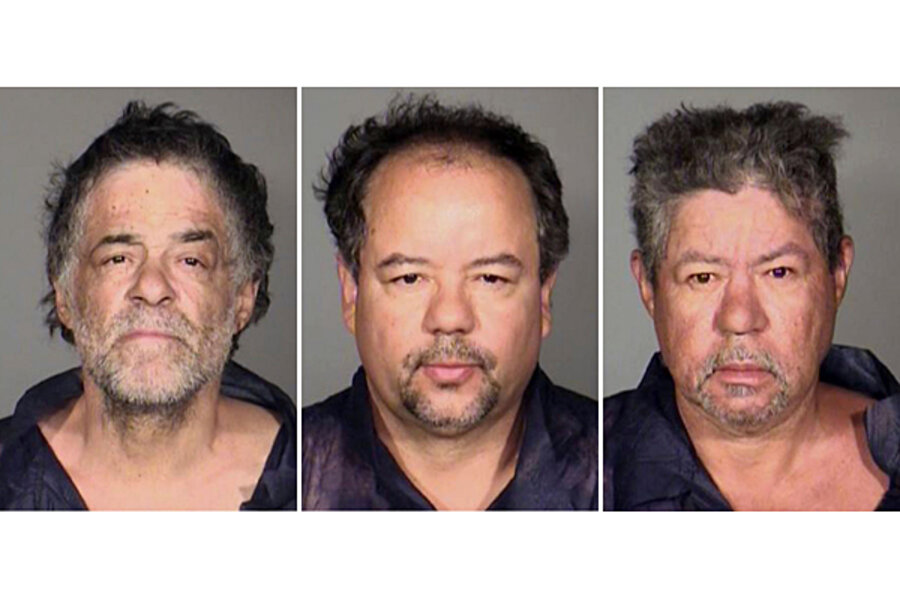Three brothers arrested: what's known so far about alleged Cleveland captors
Loading...
Authorities could file charges against three brothers accused of kidnapping and holding three women captive for 10 years as early as Wednesday morning, officials say.
Suspects Ariel Castro, Pedro Castro, and Onil Castro were arrested Monday night after Amanda Berry escaped from a house owned by Ariel Castro and called 911. Police also found missing persons Gina DeJesus and Michelle Knight in the house. The three women disappeared in separate incidents between 2002 and 2004, and all had been held captive in the Seymour Avenue house on the west side of Cleveland.
Cuyahoga County authorities have 48 hours after an arrest to file charges against the suspects, FBI spokeswoman Vicki Anderson said Tuesday. Federal and local law-enforcement officials will interview the suspects Wednesday, she said.
Details about the three men have emerged as neighbors and family members ask how and why the women could have been held for so long.
"The [brothers] were all good kids," Nelson Roman, a lifelong friend of them, told the Cleveland Plain Dealer Tuesday. "That's why this news is devastating. It's not only horrifying to the families of the kidnapped girls, it's devastating to us, because these brothers were all very good kids who grew up in a very good family. I was shocked to see their pictures on television involved in kidnapping. We've stayed friends over the years and had no idea they were keeping girls hostage."
The Castro family was among the first Puerto Rican immigrants to settle in Cleveland after World War II. The brothers grew up in a family of nine children, and their father owned a car lot in the West 25th Street neighborhood, Adrian Maldonado, who owns a construction consulting company in the area, told The Plain Dealer.
Pedro Castro, the oldest of the three brothers, was a straight-A student in high school, but dropped out his junior year because of a problem with alcohol, Mr. Roman said. Pedro worked a punch-press machine in a factory, but his drinking habits forced him to stop working. In recent years, he was receiving Social Security benefits, Roman said.
Onil Pedro, the youngest brother, also had a problem with drinking, Roman said. He made his living doing odd jobs as a handyman until he was injured while working as a laborer five years ago. Since then, he has been receiving workers' compensation, Roman said.
Middle brother Ariel Castro, who owned the house where the women were found, was known by most people in his neighborhood. He was a school bus driver for 22 years, but he was fired by the Cleveland School District last November after several incidents of “bad judgment,” including leaving a child alone on the bus, making an illegal U-turn, and using the bus to go grocery shopping, according to records released Tuesday.
Mr. Castro also played bass guitar in salsa and merengue bands.
However, he struggled to control his temper, The Plain Dealer reported.
According to a 2005 filing in Cuyahoga County Domestic Relations Court, viewed by The Plain Dealer, Castro fought over the custody of his children with his former wife, Grimilda Figueroa. She had full custody of the children, but Castro allegedly took the daughters and kept them from his wife. In the filing, Ms. Figueroa’s attorney asked the judge to "keep [Castro] from threatening to kill [Figueroa]." She suffered a broken nose, broken ribs, and two dislocated shoulders, among other injuries.
Ariel Anthony Castro, his son, told The Plain Dealer that the news of his father’s alleged involvement is “beyond comprehension.”
In 2004, Anthony Castro, as he goes by, wrote an article as a journalism student for the Plain Press, a neighborhood newspaper, about the community’s anxiety after Ms. DeJesus’s and Ms. Berry’s disappearances. He interviewed Nancy Ruiz, DeJesus’s mother, for the article.
“That I wrote about this nearly 10 years ago – to find out that it is now so close to my family – it's unspeakable,” Anthony told The Plain Dealer.
Arlene Castro, one of Ariel’s daughters, told the TV program “America’s Most Wanted” in 2005 that she was the last person to see DeJesus alive, reported WEWS-TV in Cleveland. In the years after DeJesus’s disappearance, Ariel performed at a fundraiser held in her honor and passed out fliers with her photo on it. At a candlelight vigil a year ago, he comforted Ms. Ruiz.
Anthony said that he speaks to his father only a few times a year and rarely visited the house. He told London’s Daily Mail that his last visit was two weeks ago, and his father would not let him inside.
"The house was always locked," he said. "There were places we could never go. There were locks on the basement. Locks on the attic. Locks on the garage."
City officials said Tuesday that there was no record of anyone calling to report criminal activity at the house, but they would continue to search the emergency databases. However, two of Ariel Castro’s neighbors said they called the police for separate incidents.
In November 2011, Israel Lugo heard pounding on the doors of the house. Police officers knocked on the front door, but no one answered. "They walked to the side of the house and then left," Mr. Lugo said Tuesday.
Elsie Cintron lives three houses down from Castro. Several years ago, her daughter saw a naked woman crawling in the backyard, but the “police didn't take it seriously," she said Tuesday.
• Material from the Associated Press contributed to this report.








